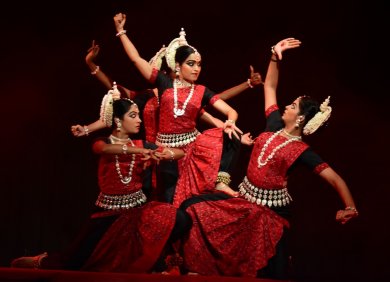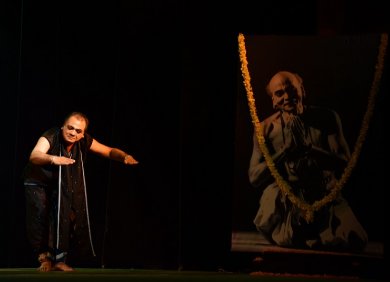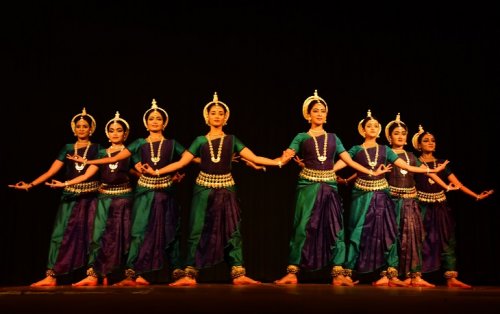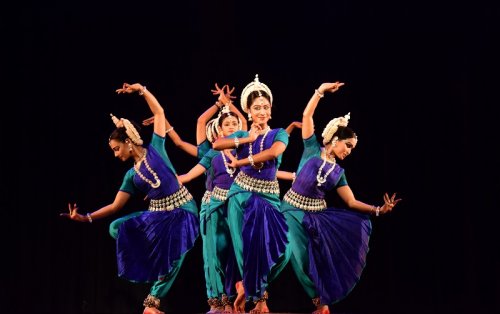
|   |

|   |
 e-mail: sunilkothari1933@gmail.com Samsmaranam: 15th anniversary of Guru Kelucharan Mohapatra Photos: Ganesh Sahoo May 3, 2019 Srjan, Guru Kelucharan Mohapatra Odissi Nrityabasa presented a two day program of Odissi dance by Srjan Ensemble and Shivagni Musical Ensemble on 6th and 7th April at Rabindra Bhavan at Jalpaiguri, West Bengal. I was told by senior local Kathak dancer Kuntal Raha that she had seen Guruji on television for the first time and invited him to Jalpaiguri in the year 1998. Many saw Guruji and were completely won over by his affectionate nature, minus any arrogance that he was a great guru. Paushali Mukherjee, a disciple of Guruji and also a mardala player, a student from Rabindra Bharati University trained in turn many young disciples, among whom was Pompi Paul from Jalpaiguri, who established Kalpodrum institution there to start teaching Odissi. Two years ago, Pompi arranged an evening of Odissi dance in Jalpaiguri but I could not make it. However, this year I got an opportunity when Guruji's son Ratikant Mohapatra, after visiting Jalpaiguri for a workshop, accepted the suggestion of Ritu, a member of Srjan Ensemble, to have Guruji's 15th anniversary program in his memory in Jalpaiguri. With help of her brother-in-law and renowned theatre director, actor Amalkumar Sengupta, Srjan planned a major event including Shivagni Music Ensemble. Thereby hangs a tale. Two years ago when conducting a workshop and performances at Kuala Lumpur, Ratikant was browsing through YouTube at 2.30am for a musical band to perform in Kuala Lumpur after the show of Srjan Ensemble. Along with him was violinist Agnimitra Behera who suggested, "Why not we create our own band?" That was the seed sown during the visit to Kuala Lumpur. Combining Ratikant's pet name Shibu, and Agnimitra's name, the band was named as Shivagni. Enrolling musicians for drums, keyboard, percussion, vocal, violin and flute, the Shivagni band was born within two months. Their first performance at Rabindra Mandap in Bhubaneswar had a full house with the who's who of the music world of Bhubaneswar in attendance. And with all the trepidation the group performed winning hearts of the connoisseurs. Those who had come with curiosity left as ardent fans. Within two years, Shivagni has given more than 25 shows and are regulars for the Odisha Govt's mega events. They have come into their own and earned a reputation they wanted to be a band from Odisha. The lead is taken by Agnimitra Behera (violin) and Srinibas Satpathy (flute) with the rest of the members Kshiti Prakash Mohapatra (vocals), Biswas Ranjan Nanda (tabla), Baivabh Kumar Das (percussion), Ramesh Chandra Behera (keyboard), Debranjan (lead guitar) and Ashok Prushty Nayak (drums). Their perfect understanding and infectious enthusiasm, spontaneous improvisation and thorough professional approach including dress code left a favourable impression and Jalpaiguri music lovers and the young generation went wild applauding the band with joy! I have always enjoyed watching rehearsals. When I was with Mrinalini Sarabhai, Kumudini Lakhia, Chandralekha, the Jhaveri Sisters, and even for solo Bharatanatyam of Sonal Mansingh, I used to attend rehearsals. It was always a lesson for me to know how the dancers were creating the work, and since I was allowed to watch, often they treated me as 'a sounding board.' Therefore, I requested Ratikant to attend morning rehearsals at Rabindra Bhavan. In their black practice costumes with red scarves, the members of the ensemble were ready at the dot. Aditya Mahapatra's deep voice introducing the choreographic work 'Viswas' was being rehearsed. Like a ballet master, choreographer, holding a mike in his hand and supervising from the auditorium, Ratikant gave instructions to dancers, who took note but continued to perform without stopping. Ratikant told me that the ensemble practices the choreographed repertoire every day in the morning from 8am till 11.30am. Naturally if that is the routine, the result is there for all to see. The alignment, the synchronization, the overall unity and perfect movements enhance the beauty of the ensemble. If symmetry adds to the beauty of group dance, it leaves a pleasant impression. Then visually with well designed costumes and dancers of uniform height and slim figures, sets Srjan ensemble apart as a professional group from other ensembles. The curating of the numbers presented in succession was praiseworthy. Beginning with Guru Kelucharan Mohapatra's choreography of 'Navadurga' in praise of Bhagavati on the occasion of beginning of Navaratri festival, was an excellent choice paying tribute to Guruji. It is one of the gems of choreography in which Kelubabu brought to life the iconic images with his exquisite touches. Devi Durga is Kalyanarupa, bestowing blessings upon devotees, remover of sins, papaharini, she is one who has annihilated the demons Shumbha and Nishumbha, she has sun and moon as adornments; her ability to kill Andhaka and Mahishasura find a felicitous choreographic expression in hands of Guruji. The goddess with multiple arms, lion as her vehicle and arms wielding several weapons, comes alive frightening Mahishasura who in his arrogance attacks the Goddess but with trident, Durga pierces his heart and vanquishes him. The dramatic build up comes to the fore. The refrain 'Namo varade Jayadevi Bhavani', interspersing with 'Ya Devi sarva bhuteshu', Guruji creates multiple images of the goddess and dancers impersonate various characters. The Sanskrit prayer is rich in images and Guruji with his imagination stuns audience with the power of the goddess.  Bhagavati Stotram  Shabari After the auspicious beginning, Ratikant presented choreographic work called 'Synthesis.' He prefers to call his work neo-classical, as he has attempted to breathe fresh elements in his approach to Odissi. Not slow but with aesthetic gradual acceleration of speed, in drut, the form flowers. Also, within the boundaries of tradition maintaining the core, he explores movements which are mentioned in Natya Shastra. The karanas offer enough scope without laying emphasis on all movements, but picking up which will suit Odissi, he has used movements of legs, lifting them up on one side and swinging it along, not exactly in 'katichhinna karana', but impression of moving the waist enough to let feet cross each other, giving a lilt to the entire frame of the body. The dancers sit on the floor while dancing and move legs in front, or they roll on the floor, all add up to not only synthesis but also extends the boundaries of the form. The shloka composed by Pt Nityananda Mishra on faith, 'Shraddha sukta' suggests the confidence the choreographer has in exploring the movements. Or when we see the dancers glide from wings on stage, it looks refreshing in terms of gati, gait. The leaps in the air look perfect, embellishing nritta. The music also has different texture in keeping with synthesis mood. 'Shabari' based on Ramacharitamanas of Tulsidas has always an instant appeal. People in North can sing along with the dancers performing. Kelubabu loved visiting and performing in Varanasi. His performances at Sankatmochan temple are legendary. Ramacharitamanas always inspired Guruji to choreograph characters from Tulsidas's compositions. Ratikant's essaying the role of Shabari was an exercise where a male dancer transcends the gender and evokes the image of Shabari, a low caste devotee of Lord Rama, awaiting his arrival when she can offer him the berries, after having tested them earlier. Ratikant's transformation as an aged Shabari, with bent back, hands atremble was extremely touching. Transforming from straight posture of Lord Rama holding bow, and blessing Shabari, who again and again places her head at the feet of Lord Rama, then making him sit, brings already tested berries, which Lord Rama enjoys with great delight were heartwarming sequences. The text when Rama and Lakshmana arrive: 'Shabari dekhi Rama griha aye, shyam gaur sundar dono bhai, Shabari pari charan akulai' resonates with emotions and the audience is moved watching the abhinaya. Begging forgiveness of Lord Rama, Shabari says: 'Ehi bidhi stuti kar hu tumhari adham jati main jana mati bhari, adham te adham adham adham ati nari' - the repetition of word adham, endears Shabari to audience, who are moved seeing her devotion. The text in Avadhi for those who know it is a bonus to hear. 'Vishwas' as a choreographic piece of Ratikant is a feather in his cap. Light designer Jayadev had originally scripted it from which it was composed drawing from Gurbani, Kabir's dohas making Gurbani as devotee asking questions and Kabir's doha as god's answer to the devotee. Very interestingly the faith of Sikhs, the Hindus, the Christians, the Muslims are interwoven and in terms of dance, the dancers pray to god folding their palms, performing Namaz, touching the earth with head and looking in either direction and raising palms heavenwards, or showing Christ being carried on back of a person, and brought to the ground where he is crucified. Then all dancers placing their hands on heart and using other arm sideways asking 'Tu hai vahe Guru', the choreography moves also to the singing 'Tu hi Ram hai, tu hi Rahim, tu hi vahe guru, Hari naam to samaje' (You are Rama and you are Rahim), and Kabir, meaning god, says: 'Kahe moko dhunde bande?' (Where are you searching for me, O devotee?), 'Bande main to tere pasa men' (I am, O devotee, within you). Kabir (god) says, 'Nor am I in a pilgrimage place, nor in any solitude, nor in temple, nor in mosque, nor in Kabe, nor in Kailasa' and so on. The dancers show how like a stream the chanting flows; with Ram Dhun, they roll on the floor then get up and form a frontal line, creating images which reinforce the oneness of the god. Ratikant has drawn inspiration from Sufi tradition and like the Sufis move in circle raising their one arm, the dancers move in circle. Kabir says: 'Suno bhai sadho main to hun vishwas men' (listen, all you devotees, I am in your faith in me that you maintain). The title Vishwas of this piece justifies the excellent exposition. How contemporary is such a classic piece of choreography by Ratikant. In troubled times and warring religious factions, this work speaks volumes.  Kirwani Madhurima  Vande Mataram I saw during Dhauli Festival in Bhubaneswar in February, 'Kirvani Madhurima' and was extremely impressed. The musical composition in Telugu by Dr. Vyzarsu Balasubrahmanyam with text in praise of the goddess, translated into Sanskrit by scholar Nityananda Mishra keeping the same meter as in Telugu, and choreographed by Ratikant, it transforms into a work of sheer beauty. The text merges with the musical mode perfectly and the dancers give both the music and the text visual shape. The melody has a haunting quality and an appeal across lovers of music of several genres. Watching it again, I enjoyed it immensely. The evening concluded with Kelubabu's evergreen choreography of 'Vande Mataram.' To strike a personal note, when I had seen it for the first time I was bowled over. I was on the committee of Khajuraho Dance Festival and insisted that Guruji himself should perform with other students and it must be presented in the festival. It had received rousing reception. Set in Desh raga, Guruji has with his painting gifts created exquisite visuals for Bankim Chandra's immortal classic in Sanskrit. Who has not heard it and not got up whenever it has been sung in any function? Ratikant has kept the original choreography intact and with such well trained dancers, the entire group work was like a cherry on the cake. Creating image of Bharatmata, with five dancers in architectural beauty of a toran, two other dancers appear from either wing and offer pranam to mother and pick up dust from the earth and place it on their head. To enhance motherly image, the central figure picks up a child and takes it to her lap. The poem speaks of 'sujalam sufalam' and on stage spring water and trees laden with fruits, in water are seen fish, on ground the deer, the peacock, the elephant, the entire world moving with joy, lotuses bloom and creepers entwine the trees, the cool breeze from Malaya mountain, the greenery everywhere, the farmers ploughing the fields, women planting the seeds, harvesting, women and men pick up the bundles on their head and they march along. The nature in its splendor with moonlight illuminating the night, the trees with fruits and flowers spreading fragrance... ah! What wonderful images Guruji has created, as it were one watches clouds floating across the sky. And we watch the group dance, mesmerized. The audience got up and gave a standing ovation to dancers and Guruji. We all felt blessed. Ratikant Mohapatra knows that he has to maintain very high standards that Guruji has established. It is not easy to carve under the shadow of a genius, one's independent signature. With his abundant gifts as a dancer, guru, mardala player, and a choreographer with a talented dance ensemble, Ratikant has established Srjan as one of India's premier Odissi dance institutions. Ratikant works towards creating awareness about Odissi dance with a modern approach, while preserving the rich classical nature of the art. With one of the best repertory groups in India, Srjan ensemble has now earned fame for its fast-paced movements, innovations in dance and music and also depiction of popular themes. As a master choreographer, he chisels his dancers who perform with uniform technique, creating a myriad of patterns, exploring various geometric groupings that astound one like watching kaleidoscopic variety of eternal beauty. Such perfection, alignments in movements et al, speak of his modern outlook, professionalism, and raising the bar of dance. As one can see, Ratikant has evolved as an artist in his own rights doing his father proud.  Shivagni Music Ensemble There was a surprise for one and all on next day, when Shivagni ensemble hypnotized the audience consisting of die-hard dance and music lovers and also the young generation. The forays into fusion by the ensemble bear the mark of the rigour and technique they display by the classicism and thereby they bring in a wonderful blend of classical and contemporary sounds of music. Beginning with Srjan raga in praise of Guru Kelucharan Mohapatra which mentioned in Sanskrit shloka about Guruji's attributes and gifts - 'Kalapriyavaram, vatsalya vishwataram, Shri Chintamani nanadanam, sudrisham, Padma Vibhushanam Guruvaram, vande Kelucharanasya padarvindam' - composed by scholar Madan Mohan Acharya, the band established the tone. There were interesting vocals by Kshiti, 'Saptasuran manabhavan, sab jag mil gave ....pragat bhayo, rajani ko timir gayo srijan bhaye'. Raga Bairagi evoked bhakti bhava. And the confluence of a traditional bandish with a western influence was set to druta eka tali. In 'Moving together' in Ragamala in Hindustani music, the attempt was made to compare with Irish bag pipe, musical notes of our classical ragas like Bageshri, Todi, Bhupali, Kalavati, around 17 ragas, adapted to the swaras of the flute and chords of violin. The percussion dholak, tabla, in drut and led by Agnimitra on violin and Srinibas Satpathy on flute created joyous mood. The 'Mountain Mists' in raga Pahadi and Dhani created the atmosphere of listening to the flute in mountains, the mists almost floating before our eyes, the shepherd driving the herd of sheep and beautiful maidens, say from Himachal Pradesh, moving and dancing with their colorful costumes. The folk song tunes jelled well. The bols of tak dhina dhin, tak dhina dhina were full of rhythm and one could visualize group of folk dancing. Vibrant folk traditions of India imbibing elements of folk culture of Odisha were well incorporated. Raga Charukeshi was used for the 'Shivagni Hymn'. With melodious aalap, the musicians took us to the world of musical notes drenched in sweetness. The violin worked wonders in this aspect, exploring raga in its multiple intricacies. Jugalbandhi between dholak and tabla and then tanum tanum tana dere na tana dere na, the range of voice with sargam in succession and rendering the 'lakshanagit' of Charukesi mentioning in the text 'Shivagni samarpita' was imaginatively captured. In item titled 'Odissi', the band played three Odissi songs 'Sangini re', 'Dekho go' (closer to champu song) and 'Braja Raj'. I understand that it would have instant appeal because of Odiya ethos and would be a big hit as these songs are of shared tradition. It was in a novel musical arrangement of guitar, tabla, dholak and other special instruments typical to Odissi. In 'Arabian Nights' in raga Bhairavi, the vocalist Kshiti Prakash interestingly wove tunes of Arabian music imaginatively. 'Colours of creativity' highlighted identity of each musical instrument. The musicians used the format of sawal jawab, repartee, duet, trio and multiple variations to bring out a multitude of musical effects. In one track titled 'Tempest' rising to a crescendo in fast tempo, in the end it featured rhythmic intricacies in a captivating manner. Dissimilar from classical music in terms of the use of drums to create the fast spaced rhythmic effect based on raga Vasant Mukhari, it succeeded in creating mood of climax. The finale with 'Vande Mataram' in complete contrast to earlier crescendo but then taking into account the love of the young in the audience for the popular latest version by AR Rehman, and finally 'Jo mori surat pyar di, Jo ma tujhe salaam' and Vande Mataram, the ecstatic audience screaming joyously, brought the evening to an end. There is no doubt that with such a wide repertoire, Shivagni music ensemble is bound to be in great demand. Guru Kelucharan Mohapatra has touched the lives of many, not only innumerable disciples, but also audiences world over. Samsmaranam was an apt tribute to Guruji.  Dr. Sunil Kothari is a dance historian, scholar, author and critic, Padma Shri awardee and fellow, Sangeet Natak Akademi. Dance Critics' Association, New York, has honoured him with Lifetime Achievement award. Post your comments Please provide your name and email id when you use the Anonymous profile in the blog to post a comment. All appropriate comments posted with name & email id in the blog will also be featured in the site. |